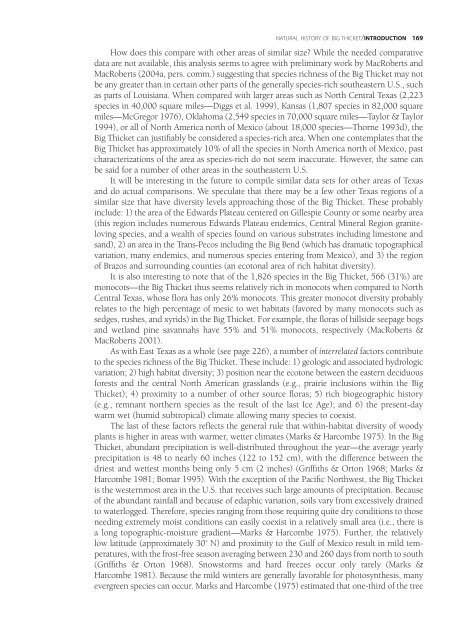ILLUSTRATED FLORA OF EAST TEXAS - Brit - Botanical Research ...
ILLUSTRATED FLORA OF EAST TEXAS - Brit - Botanical Research ...
ILLUSTRATED FLORA OF EAST TEXAS - Brit - Botanical Research ...
Create successful ePaper yourself
Turn your PDF publications into a flip-book with our unique Google optimized e-Paper software.
NATURAL HISTORY <strong>OF</strong> BIG THICKET/INTRODUCTION 169<br />
How does this compare with other areas of similar size? While the needed comparative<br />
data are not available, this analysis seems to agree with preliminary work by MacRoberts and<br />
MacRoberts (2004a, pers. comm.) suggesting that species richness of the Big Thicket may not<br />
be any greater than in certain other parts of the generally species-rich southeastern U.S., such<br />
as parts of Louisiana. When compared with larger areas such as North Central Texas (2,223<br />
species in 40,000 square miles—Diggs et al. 1999), Kansas (1,807 species in 82,000 square<br />
miles—McGregor 1976), Oklahoma (2,549 species in 70,000 square miles—Taylor & Taylor<br />
1994), or all of North America north of Mexico (about 18,000 species—Thorne 1993d), the<br />
Big Thicket can justifiably be considered a species-rich area. When one contemplates that the<br />
Big Thicket has approximately 10% of all the species in North America north of Mexico, past<br />
characterizations of the area as species-rich do not seem inaccurate. However, the same can<br />
be said for a number of other areas in the southeastern U.S.<br />
It will be interesting in the future to compile similar data sets for other areas of Texas<br />
and do actual comparisons. We speculate that there may be a few other Texas regions of a<br />
similar size that have diversity levels approaching those of the Big Thicket. These probably<br />
include: 1) the area of the Edwards Plateau centered on Gillespie County or some nearby area<br />
(this region includes numerous Edwards Plateau endemics, Central Mineral Region graniteloving<br />
species, and a wealth of species found on various substrates including limestone and<br />
sand), 2) an area in the Trans-Pecos including the Big Bend (which has dramatic topographical<br />
variation, many endemics, and numerous species entering from Mexico), and 3) the region<br />
of Brazos and surrounding counties (an ecotonal area of rich habitat diversity).<br />
It is also interesting to note that of the 1,826 species in the Big Thicket, 566 (31%) are<br />
monocots—the Big Thicket thus seems relatively rich in monocots when compared to North<br />
Central Texas, whose flora has only 26% monocots. This greater monocot diversity probably<br />
relates to the high percentage of mesic to wet habitats (favored by many monocots such as<br />
sedges, rushes, and xyrids) in the Big Thicket. For example, the floras of hillside seepage bogs<br />
and wetland pine savannahs have 55% and 51% monocots, respectively (MacRoberts &<br />
MacRoberts 2001).<br />
As with East Texas as a whole (see page 226), a number of interrelated factors contribute<br />
to the species richness of the Big Thicket. These include: 1) geologic and associated hydrologic<br />
variation; 2) high habitat diversity; 3) position near the ecotone between the eastern deciduous<br />
forests and the central North American grasslands (e.g., prairie inclusions within the Big<br />
Thicket); 4) proximity to a number of other source floras; 5) rich biogeographic history<br />
(e.g., remnant northern species as the result of the last Ice Age); and 6) the present-day<br />
warm wet (humid subtropical) climate allowing many species to coexist.<br />
The last of these factors reflects the general rule that within-habitat diversity of woody<br />
plants is higher in areas with warmer, wetter climates (Marks & Harcombe 1975). In the Big<br />
Thicket, abundant precipitation is well-distributed throughout the year—the average yearly<br />
precipitation is 48 to nearly 60 inches (122 to 152 cm), with the difference between the<br />
driest and wettest months being only 5 cm (2 inches) (Griffiths & Orton 1968; Marks &<br />
Harcombe 1981; Bomar 1995). With the exception of the Pacific Northwest, the Big Thicket<br />
is the westernmost area in the U.S. that receives such large amounts of precipitation. Because<br />
of the abundant rainfall and because of edaphic variation, soils vary from excessively drained<br />
to waterlogged. Therefore, species ranging from those requiring quite dry conditions to those<br />
needing extremely moist conditions can easily coexist in a relatively small area (i.e., there is<br />
a long topographic-moisture gradient—Marks & Harcombe 1975). Further, the relatively<br />
low latitude (approximately 30˚ N) and proximity to the Gulf of Mexico result in mild temperatures,<br />
with the frost-free season averaging between 230 and 260 days from north to south<br />
(Griffiths & Orton 1968). Snowstorms and hard freezes occur only rarely (Marks &<br />
Harcombe 1981). Because the mild winters are generally favorable for photosynthesis, many<br />
evergreen species can occur. Marks and Harcombe (1975) estimated that one-third of the tree
















